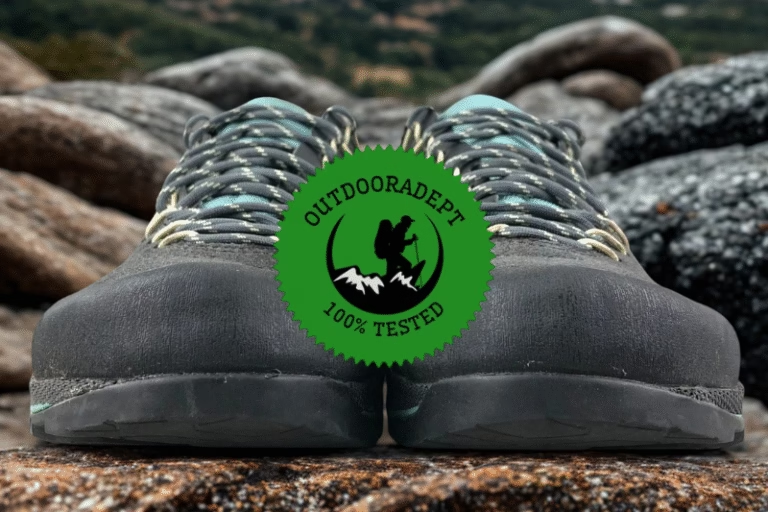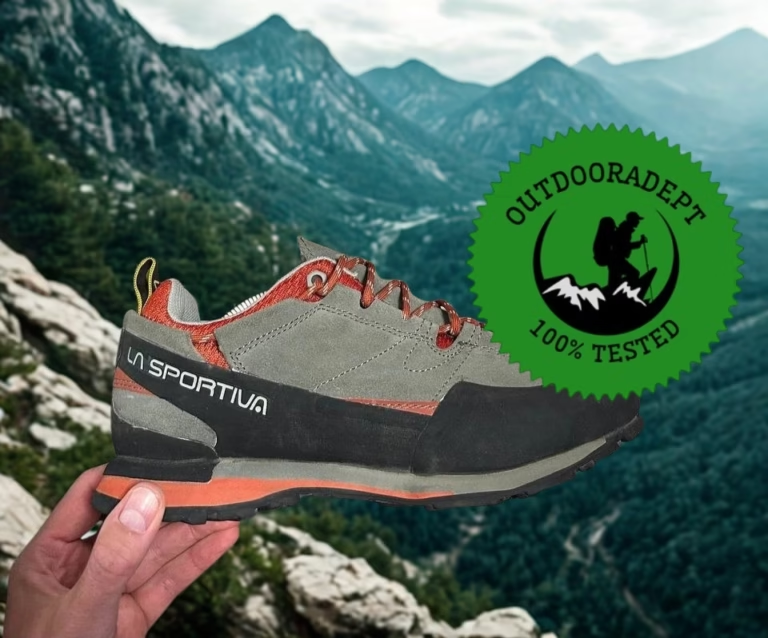My recent three-day loop through the Bucegi Mountains with the Scarpa Crux gave me more than enough time to form opinions. Some good, some worth mentioning.
For context, I’ve been wearing Scarpa footwear for over a decade now. Started with their Zen Pro approach shoes back when I was still figuring out what “approach” even meant, then worked my way through various iterations of the Mescalito line.
That history meant I went into this test with specific expectations, realistic ones, I’d like to think.
Our Verdict
The Crux has a rather narrow toe box, which bothered me during the first few hours, though it did soften up as the leather broke in.

What I got in return was impressive traction from the newer Vibram Megagrip outsole and a level of underfoot support I’d normally expect from mid-cut hikers.
Let me walk you through what I found.
Highlights
| Feature | Scarpa Crux |
|---|---|
| Weight | Women’s: ~1 lb 10 oz per pair (740 g), US 8.5 Men’s: ~1 lb 11 oz per pair (766 g), US 9 |
| Water Resistance | Water-resistant 1.8 mm suede leather upper; repels light rain and splashes, but not fully waterproof |
| Traction | Vibram® Megagrip Vertical Approach outsole with smooth climbing zone at the toe and aggressive heel lugs; strong grip on dry and wet rocks |
| Comfort | Dual-density EVA midsole with softer heel insert; supportive yet cushioned for long approaches |
| Adjustability | To-the-toe lacing system for precise fit and stable heel hold |
| Breathability | Moderate; mesh tongue enhances airflow, though suede runs warm in hot weather |
| Durability | Full suede upper with Kevlar webbing and rubber rand; built for abrasion resistance and long-term wear |
| Arch Support | Medium-firm; balanced support for neutral arches and moderate pack weights |
| Toe Protection | Full rubber toe rand and reinforced forefoot; excellent protection against sharp rock and debris |
Pros & Cons
PROS
CONS
Things We Tested When We Reviewed Scarpa Crux
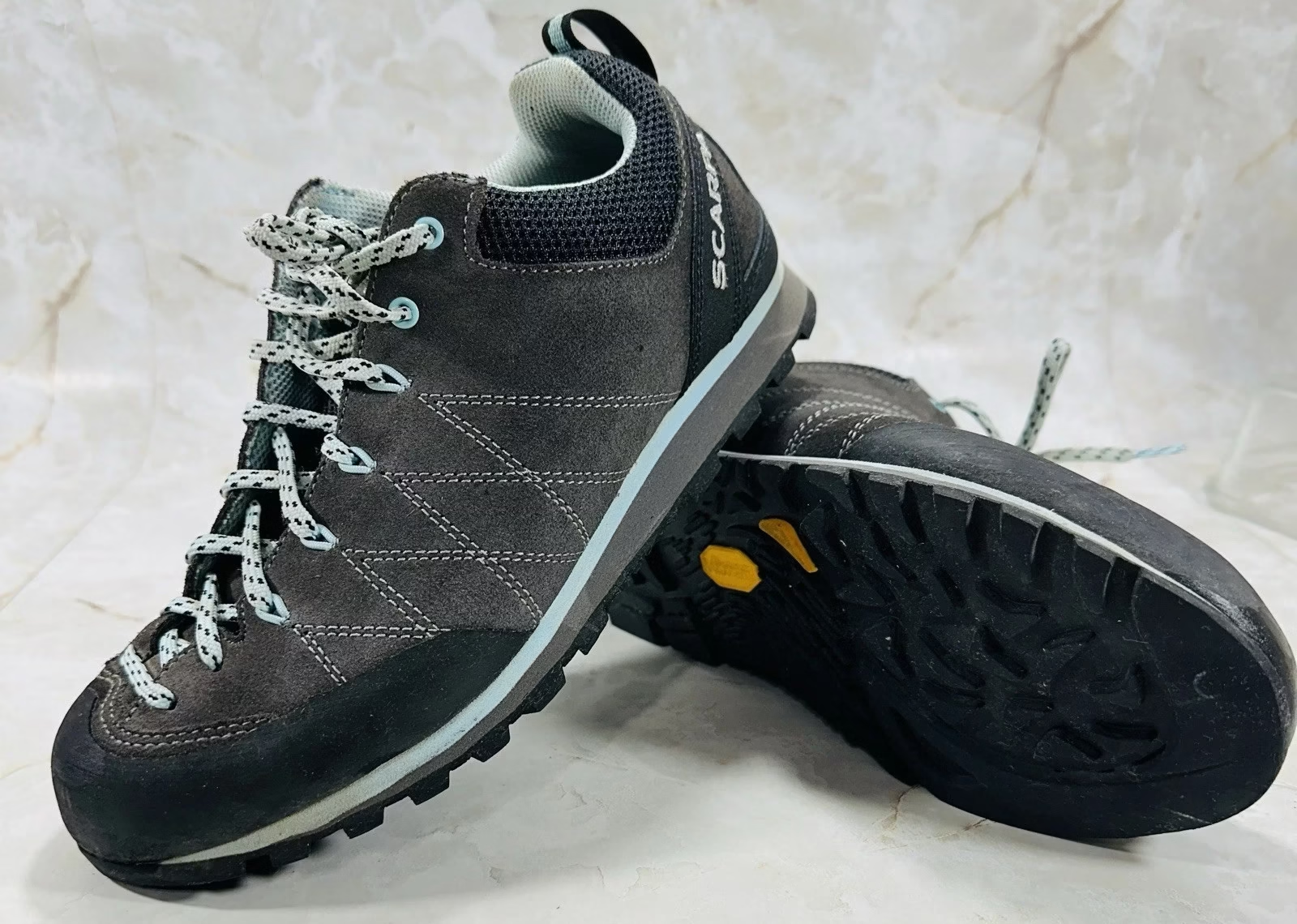
Traction
Scarpa made the switch to a Vibram Megagrip outsole on their Vertical Approach platform, and the difference is immediately obvious compared to the older Idrogrip compound.

Edging, smearing, braking on descents: all performed equally well. The lug pattern strikes this nice balance between friction and bite. You’ve got the smooth climbing zone near the toe for more technical moves, then chunkier 3-4mm lugs at the heel that really dig in on downhills.
After logging hours on mixed terrain (wet moss, dusty scree, slick rock faces), I rarely felt the sole give way. The compound lives up to its reputation as Vibram’s stickiest formula, handling both dry ridge scrambles and those sketchy damp forest descents with the kind of grip that builds confidence.
The heel brake system provides real control on steep downhills, which matters more than people realize. Prevents that sliding sensation that makes loose descents absolutely miserable.
The only trade-off is sensitivity. The cushioning does dull ground feel somewhat on really precise technical moves. For fifth-class climbing, you’ll notice less feedback than you’d get from an actual climbing shoe, but for approaches and scrambles, it’s a compromise I’ll take every time.
Durability
The leather upper has Kevlar webbing woven around the forefoot, which gives it this almost indestructible quality. I spent several days scraping these shoes across sharp limestone and through abrasive scree, and the surface is barely marked. That full PU TechLite rand wrapping the base does its job too, protecting the toe from impacts while keeping stitching well away from direct rock contact.
After weeks of use, there’s no pilling or fraying of the interior lining, and the outsole shows only modest wear despite the abuse I put it through. Plus, the rubber toe cap is still firmly attached without any hint of peeling or separation.
The laces did wear out quicker than I’d like for a shoe at this price – that was mildly annoying. The metal eyelets held up perfectly, though. I’d come across complaints about heel lining failures in earlier Crux versions, so I kept watching for that. Never happened with mine.
Comfort
For rock-climbing gear this protective, the Scarpa Crux felt surprisingly comfortable once it settled in. The upper hugged my foot tightly straight out of the box (almost too snug around the forefoot, if I’m being honest).
Yet, a few hours of wear changed that completely, as the suede started to soften and molded itself to my feet.
The midsole uses ACTIV Impact technology, which cushions the heel nicely and soaks up impact on long descents. I put in multiple eight-plus-hour days without any sore arches or hot spots developing, and that tells you something about how well the comfort holds up.
The shoe has this moderate stiffness that gives you stability on uneven ground without feeling like you’re wearing bricks, a problem I’ve dealt with in heavier approach shoes before.
Compared with the previous Crux version I tested a few years back, this model feels slightly softer underfoot. Still maintains its shape after carrying weight all day though, which matters when you’re actually using these for their intended purpose.
Breathability
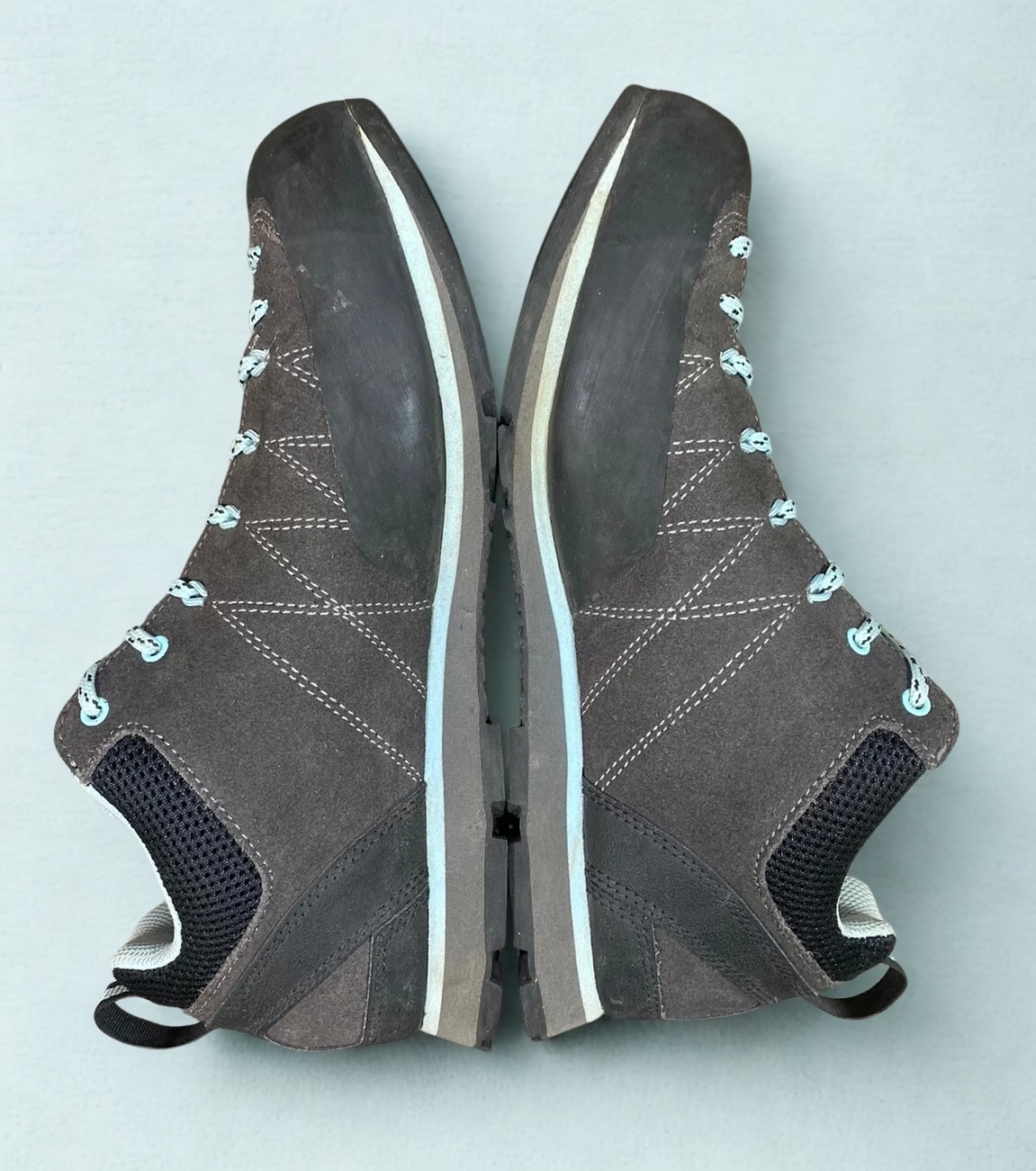
The Scarpa Crux isn’t winning any ventilation awards, but it performs reasonably well given its durable construction. The leather prioritizes protection and abrasion resistance over maximum airflow. That’s the reality of the design choice. After several hours of hiking, my feet felt warm but never swampy or unbearable.
The full mesh tongue helps more than I initially expected. Air circulates through the top pretty effectively. The lining incorporates perforated mesh sections that wick moisture away before it can build up into that clammy feeling.
That said, the suede panels dominating the upper do trap more heat than synthetic mesh alternatives would. If you’re used to trail runners, the Crux will feel noticeably warmer.
I’d characterize its ventilation as moderate but adequate for three-season use: suitable for most conditions except midsummer lowland hiking when temperatures push past 25°C.
Weight
At 383 grams per shoe for my men’s size 9, the Crux weighs approximately 1 lb 11 oz total for the pair. Women’s models clock in around 326-370 grams per shoe, depending on size.
That’s definitely not lightweight by modern approach shoe standards. After carrying them up several thousand meters during my trip, I noticed the extra weight compared to mesh competitors.
That weight comes from somewhere, though: the 1.8mm suede leather, substantial rubber protection, dual-density EVA midsole, and stiff support platform all add mass.
The Crux weighs roughly 3-4 ounces more per pair than mesh alternatives like the La Sportiva TX2, which feels like a reasonable trade for durability and weather resistance. Compared to hiking boots, these feel light and nimble.
Waterproofing
The Scarpa Crux isn’t marketed as waterproof, and that’s actually a deliberate choice I appreciate. The treated upper naturally repels light moisture (drizzle, puddles, damp grass) without noticeable absorption. The gusseted tongue keeps debris and splashes out effectively, and the interior stays dry under typical day-hike conditions.

After about 30 minutes in sustained wet conditions, though, water starts seeping through the flex points around the toe and sides. That’s just physics. During stream crossings, I waded through ankle-deep water, and my feet stayed dry for roughly 25 minutes afterward, which is actually impressive for non-GTX construction.
The lack of a membrane allows better breathability and considerably faster drying. A quick overnight dry with newspaper stuffing restores the suede completely. For wetter environments, Scarpa offers the Crux GTX with Gore-Tex lining, but for everyday use, this model’s light weather protection feels perfectly calibrated.
Support
Support is where the Crux really excels beyond what you’d expect from its low-cut design. Despite lacking ankle coverage, these approach shoes offer stability approaching that of lightweight hiking boots, which is kind of remarkable when you think about it.
The platform with ACTIV Impact technology provides firm cushioning that absorbs shock without feeling overly soft or mushy. The upper adds substantial structure and helps maintain foot alignment on angled terrain.
The only trade-off is reduced ground feel. You won’t sense rock edges as precisely as you would in lighter, more flexible options. But that’s the bargain you make for this level of support.
Fit and Sizing
I typically wear US 9 in approach shoes, but with the Crux built on Scarpa’s BN last, sizing requires some attention. The shoe runs slightly long, and I’ve read reports of many users successfully going down a half size for a more performance-oriented fit.

I stuck with my usual size and achieved a proper fit, though I could have sized down to 8.5 for tighter climbing precision. This last creates a relatively narrow toe box that tapers toward the front.
If you have wider feet, this will likely create pressure points – just being honest about that. My medium-width feet fit comfortably after the break-in period, and the material does stretch slightly with use.
The lacing system lets you fine-tune fit from heel to toe, which becomes important when feet naturally swell during long days.
Those with wider feet or prominent bunions might want to look at the Scarpa Mescalito Planet instead, which accommodates broader dimensions better.
How Does It Compare with Other Products?
La Sportiva TX4

The TX4 offers premium approach shoe performance with full leather construction and exceptional durability. It uses the same Vibram Megagrip compound as the Crux, so traction on rock is comparable.
However, the TX4 is noticeably heavier (about 4-5 ounces more per pair at roughly 1 lb 10 oz for men’s size 9). That extra weight buys you a wider toe box, even more supportive platform with STB Control System and TPU shank, and thicker leather construction.
The TX4’s build quality edges out the Crux slightly, with more substantial protection overall. For serious alpine use with heavy loads or extended expeditions, the TX4 justifies its premium. For general approach work and moderate scrambling, the Crux provides better value.
For more details of this approach shoe, check out our review of the La Sportiva TX4.
Salewa Wildfire GORE-TEX
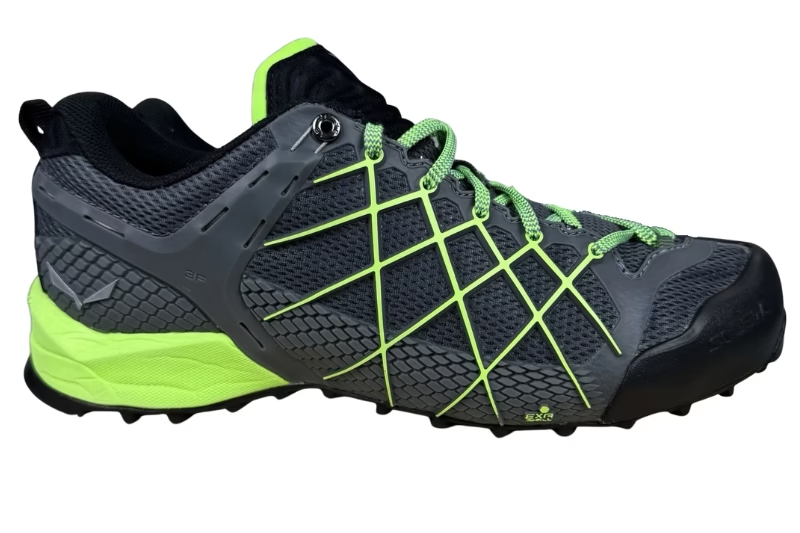
The Salewa Wildfire GORE-TEX goes all-in on weather protection and athletic comfort. The synthetic upper paired with a waterproof membrane makes it great for wet, variable conditions. The trade-off is breathability, as the membrane restricts airflow considerably.
Traction-wise, the Wildfire’s Pomoca outsole performs well on dry rock. Wet stone is another story. That’s where the Crux’s Megagrip rubber really shows its superiority: noticeably more secure footing when conditions get slick.
They’re similar in weight, but the Crux feels more supportive when you’ve got a loaded backpack.
Check our Salewa Wildfire GTX Review for the full picture.
Scarpa Rapid XT
The Scarpa Rapid XT is a hybrid between a trail runner and a climbing shoe: nimble, cushioned, built for covering ground quickly on mountain trails.
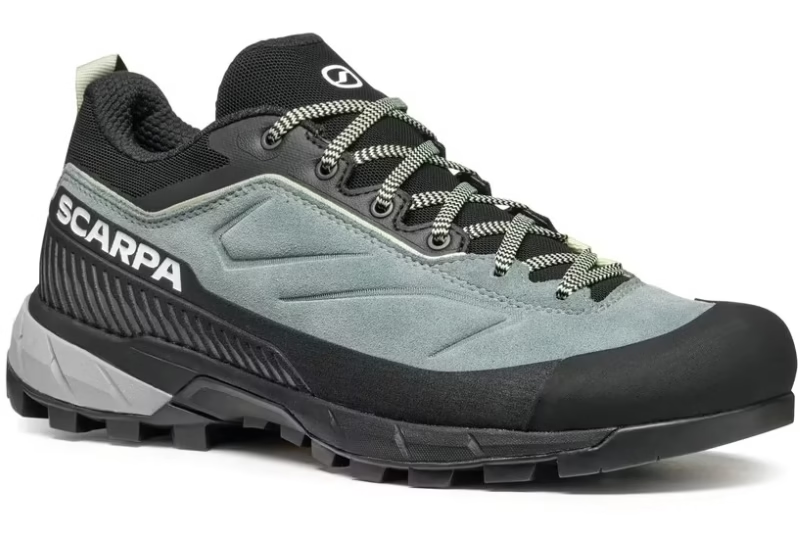
The Presa outsole, combined with a dual-density EVA midsole, gives you excellent rebound, but you’re giving up underfoot protection compared with what the Crux offers.
I grab the Rapid XT for speed-focused hikes and easier approaches. Routes involving rough terrain or heavier packs send me back to the Crux every time.
Where the Scarpa Crux Performs Better
The Crux excels on technical approaches, mixing hiking with scrambling where you need footwear that transitions confidently between terrain types. Think third and fourth-class scrambles, boulder fields, and talus slopes where precision matters but you’re not roping up.
It’s ideal for multi-day mountain objectives carrying moderate packs – the support and stability shine when you’ve got 10-15kg on your back, navigating unstable ground.
Shoulder-season conditions with variable weather favor the suede’s water resistance and protection. If you’re a frequent scrambler who needs durable rock climbing gear that won’t fail after a season, the Crux delivers. It’s also great for alpine approaches where the descent involves technical terrain and you can’t just wear sandals back down.
Where the Scarpa Crux Falls Short in Performance
These aren’t the shoes for fast-and-light trail running or long days on smooth, established trails where their stiffness and 1 lb 11 oz weight feel excessive. Hot, humid climates expose the leather’s limited breathability – I’d choose mesh alternatives for tropical or desert conditions.
The wide fit works for most feet but can feel sloppy if you have narrow or very low-volume feet, while simultaneously being too tight for genuinely wide feet.
At 383 grams per shoe, they’re too heavy to comfortably carry on your harness for multi-pitch rock climbing unless you specifically need them for the descent. The maintenance requirements (treating leather regularly, replacing laces)add hassle compared to synthetic shoes.
If you primarily hike mellow trails without technical sections, lighter options exist that’ll serve you better.
Do We Recommend the Scarpa Crux?
Yes, with caveats. My five days of testing these on demanding Bucegi terrain proved their worth for technical mountain use. The exceptional Vibram Megagrip traction, bomber suede durability, and genuine all-day comfort make them excellent approach shoes for serious alpine work.
However, they run warm, require regular maintenance, and the narrow toe box won’t suit everyone. Size carefully – consider going down a half size if you want a performance fit.
If you primarily hike mellow trails, lighter mesh options make more sense. But for scrambling, technical approaches, and mixed terrain with moderate to heavy loads, the Crux delivers genuine capability that justifies the investment.
Where to Buy It?
| WHERE TO BUY? | MEN | WOMEN |
| Amazon | See Pricing» | See Pricing» |
| Backcountry | See Pricing» | See Pricing» |
| REI | See Pricing» | See Pricing» |
FAQs
Most SCARPA shoes are made in Italy, where the company was founded and still operates its main production facility. However, some entry-level models are produced in Romania or Asia. The Scarpa Crux is labeled “Country of Origin: Vietnam”
You shouldn’t machine-wash SCARPA climbing shoes. Instead, clean them gently with lukewarm water, mild soap, and a soft brush or cloth. Avoid heat and direct sunlight when drying — let them air dry naturally to preserve shape and rubber performance.






